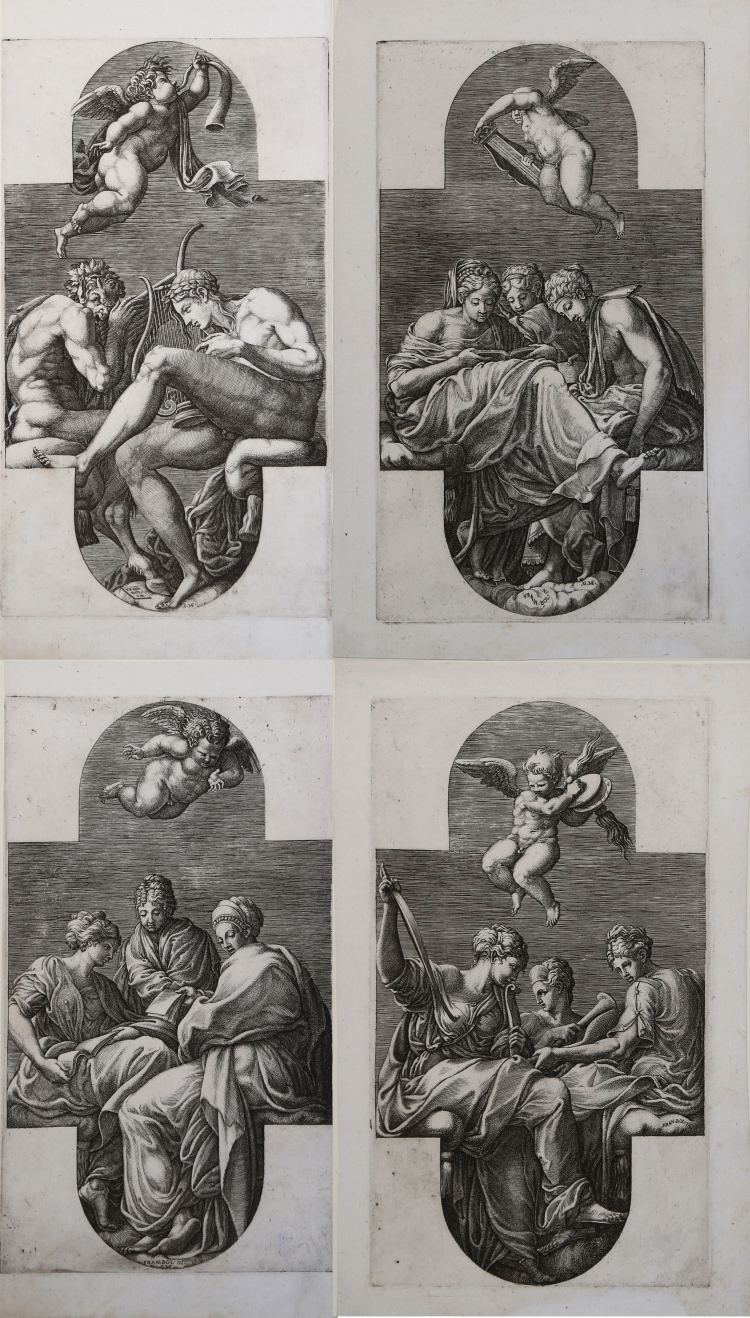











| Reference: | S36945 |
| Author | Giorgio GHISI detto "Il Mantovano" |
| Year: | 1550 ca. |
| Measures: | 166 x 291 mm |










| Reference: | S36945 |
| Author | Giorgio GHISI detto "Il Mantovano" |
| Year: | 1550 ca. |
| Measures: | 166 x 291 mm |
A complete series of four vertical engravings after Francesco Primaticcio:
- Three Muses and a Putto with Cymbals. Signed lower center with monogram: 'G.MAF.', inscribed on the cushion to the right: 'FRAN. BOL. IN.'
- Three Muses and a Putto with a Lyre. Signed lower right with monogram: 'G.MAF' and inscribed: 'FRAN. BOL. IN.'
- Three Muses and a Gesturing Putto. Signed lower center with monogram: 'G.MAF' and inscribed above: 'FRAN. BOL. IN.'
- Apollo, Pan, and a Putto Blowing a Horn. Signed with monogram on the cushion at bottom left: 'G.MAF.' and inscribed on a tablet: 'FRAN./BOL./IN.'
According to Mariette, these four prints were based on compositions surrounding a central image of Venus and the three Fates in the vault pf the fourth bay in the Galerie d’Ulysse at Fontainebleau.
Examples of the final state, with the Antonio Lafreri' address erased.
Magnificient proofs, printed on contemporary laid paper with "eagle in crowned cirlce" watermark (Briquet 207, Lewis 13; Rome 1573-76 circa), with margins or trimmed to the platemark, excellent conditions.
|
Bartsch XV.404.34, 36, 37, 38; Boorsch, Lewis, and Lewis 1985, no. 34 – 37;Bellini 1998, no. 46-49.
|
Giorgio GHISI detto "Il Mantovano" (Mantova 1520 - 1582)
|
Giorgio Ghisi or Chizi, or Ghizi, aka Mantovano, was born in Mantua in a family from Parma who lived in Mantua between 1515 and 1525. He died in the same city in 1582.
Giorgio was paiter, carver, “operatore all’azzimina” (he worked with jewels) and engraver. His first print bears the date 1543, although it is possible that he had already started his career as engraver even before, in the school of Giovanni Battista Scultori (1503 – 1575) and working with Giulio Romano who came to Mantua in 1524 to decorate Palazzo del Tè. Giorgio left Mantua after Giulio’s death, in 1546, and he went to Rome to meet his fellow citizen Pietro Faccetti, during the pontificate of Paul III (1534 – 1549).
At the age of thirty, between 1549 and 1550, Ghisi left Italy and went to Antwerp, the most important cultural city in Europe, for he had been invited by the publisher Hieronymus Cock.
From Antwerp he moved to Paris and there he published prints form Luca Penni and Giulio Romano bearing the King’s Privilege. He remained in Paris until 1560 approximately.
In 1578 he must have engraved his last plates; we know that from that point and till his death, he worked for Vincenzo Gonzaga as jewel designer.
Bartsch and Passavant had catalogued about 70 prints, while Hubert registered just 31; D’Arco lists 44 subjects and the Lewis’ 63.
|
|
Bartsch XV.404.34, 36, 37, 38; Boorsch, Lewis, and Lewis 1985, no. 34 – 37;Bellini 1998, no. 46-49.
|
Giorgio GHISI detto "Il Mantovano" (Mantova 1520 - 1582)
|
Giorgio Ghisi or Chizi, or Ghizi, aka Mantovano, was born in Mantua in a family from Parma who lived in Mantua between 1515 and 1525. He died in the same city in 1582.
Giorgio was paiter, carver, “operatore all’azzimina” (he worked with jewels) and engraver. His first print bears the date 1543, although it is possible that he had already started his career as engraver even before, in the school of Giovanni Battista Scultori (1503 – 1575) and working with Giulio Romano who came to Mantua in 1524 to decorate Palazzo del Tè. Giorgio left Mantua after Giulio’s death, in 1546, and he went to Rome to meet his fellow citizen Pietro Faccetti, during the pontificate of Paul III (1534 – 1549).
At the age of thirty, between 1549 and 1550, Ghisi left Italy and went to Antwerp, the most important cultural city in Europe, for he had been invited by the publisher Hieronymus Cock.
From Antwerp he moved to Paris and there he published prints form Luca Penni and Giulio Romano bearing the King’s Privilege. He remained in Paris until 1560 approximately.
In 1578 he must have engraved his last plates; we know that from that point and till his death, he worked for Vincenzo Gonzaga as jewel designer.
Bartsch and Passavant had catalogued about 70 prints, while Hubert registered just 31; D’Arco lists 44 subjects and the Lewis’ 63.
|